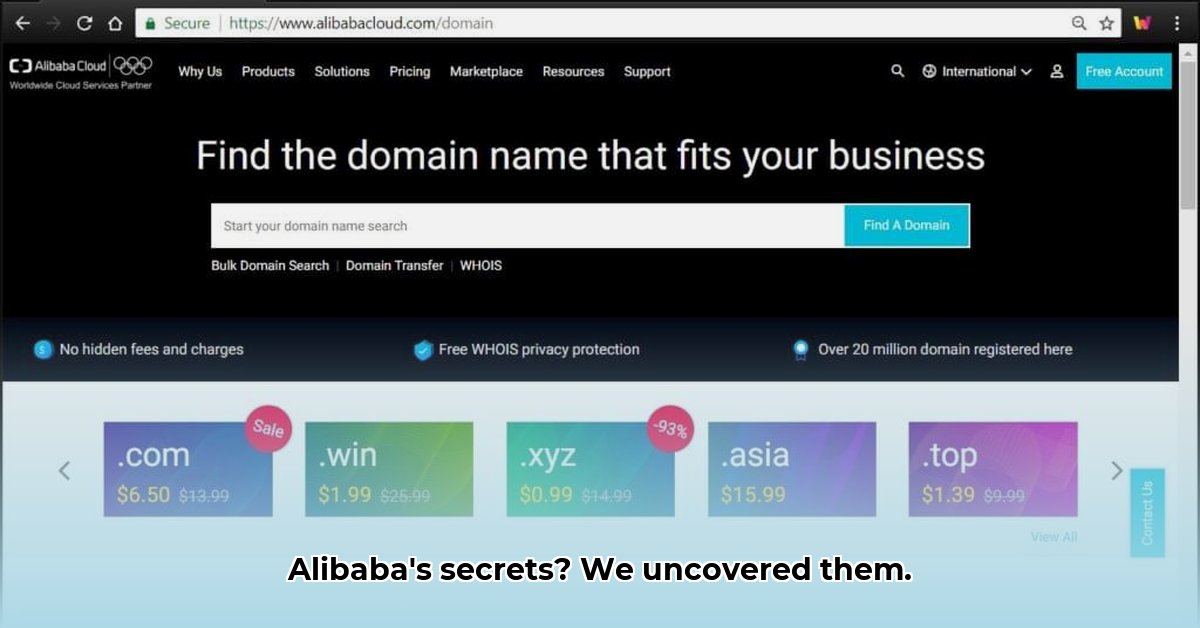
Alibaba WHOIS: A Comparative Analysis of Data Sources
This report analyzes the discrepancies in WHOIS data (domain registration information) for Alibaba, comparing information obtained from two prominent sources: Alibaba Cloud's WHOIS service and the IANA WHOIS service. Understanding these discrepancies is crucial for researchers, businesses, and regulatory bodies seeking accurate information about Alibaba's online presence. WHOIS data, while publicly accessible, presents complexities that necessitate a multi-source approach for reliable verification.
Areas of Agreement: Foundational Data Points
Both Alibaba Cloud and IANA confirm key aspects of Alibaba Group Holding Limited's domain registrations. Both sources agree on the registration's active status, the registrant (Alibaba Group Holding Limited), and the commencement date of registration (January 8th, 2016) for the .alibaba top-level domain. Furthermore, both sources provide contact information, although the level of detail and the precise formatting differ. The existence of this common ground provides a baseline for further analysis of the data discrepancies. However, the minor discrepancies in contact details raise questions about the consistency and completeness of WHOIS data across different platforms.
Data Discrepancies: Highlighting the Challenges
The most significant finding is the striking difference in the comprehensiveness of data provided by Alibaba Cloud versus IANA. Alibaba Cloud's WHOIS service frequently yielded limited or generic responses ("Sorry, that doesn't seem right") when querying common Alibaba domain names. In contrast, IANA's service offered significantly more detailed information, including complete nameserver details—which are essentially the website's online addresses—and more comprehensive contact information compared to the information provided by Alibaba Cloud. This stark contrast underscores the limitations of relying on a single WHOIS source. Why this difference exists requires further investigation into the data management practices of each organization, and potential data privacy protocols. Does this mean information is intentionally hidden, or merely that sources have differing levels of updates, accuracy, and completeness?
Interpreting the Discrepancies: Factors Influencing WHOIS Data
The observed inconsistencies are not necessarily indicative of malicious intent; rather, they highlight several factors that influence the accuracy and completeness of WHOIS data.
- Data Update Frequency: Different WHOIS services update their databases at varying intervals. A delay in updating one database can create a discrepancy versus another data source.
- Registry Practices: The methods used by different registries to collect and maintain WHOIS data vary, leading to potential inconsistencies in data formats and completeness.
- Data Privacy Regulations: Privacy concerns and regulations like GDPR and CCPA influence the amount of information made publicly available through WHOIS, further complicating cross-source comparisons.
- Organizational Structure: Alibaba's complex global structure may also contribute to variations in contact information across different sources, as data may be managed by various teams across the organization.
These factors underscore the need for a multi-pronged approach to verifying domain registration details and the challenges of relying solely on WHOIS data for verification. How can we be sure that inconsistencies are not covering up malicious intent, for example?
Actionable Insights for Key Stakeholders
The findings presented herein have significant implications for various stakeholders:
- Researchers: Multiple WHOIS sources should always be consulted, and methods for verifying data should be adopted that incorporate analysis from related sources.
- Businesses: Due diligence procedures should go beyond WHOIS data, incorporating complementary sources of information.
- Registrars: Improvements to data quality control measures and standardization of data reporting are necessary to enhance data consistency.
- Regulatory Bodies: Mechanisms for promoting data consistency across different registries and enhancing data accuracy are crucial.
A multi-source approach, combined with the use of alternative data validation tools, is recommended to mitigate the risks related to inaccurate or incomplete information.
Risk Assessment Matrix
The following matrix outlines the potential risks associated with relying solely on WHOIS data:
| Risk Factor | Likelihood | Impact | Mitigation Strategy |
|---|---|---|---|
| Inaccurate/Incomplete Data | Medium | High | Cross-reference with multiple WHOIS sources; use alternative validation methods. |
| Outdated Information | Medium | Medium | Utilize regularly updated WHOIS APIs, where available. |
| Data Manipulation/Misrepresentation | Low | High | Conduct thorough due diligence with other corroborating evidence. |
Regulatory Implications and Future Outlook
The inconsistencies highlighted in this report highlight the need for increased regulation and standardization in WHOIS data management. Compliance with data privacy regulations (GDPR, CCPA) and international best practices is vital for ensuring the reliability of WHOIS as a crucial information source. Better collaboration between registries, governments, and technology firms is needed to develop more robust data governance frameworks. The future hinges on a collaborative effort to improve data quality, consistency, and overall reliability. Therefore, further research into advanced data validation techniques and improved data sharing protocols is paramount. The ultimate goal is to ensure that WHOIS data remains a trustworthy source of information for all stakeholders.
Improving WHOIS Data Verification: A Step-by-Step Guide
This section provides a practical guide for verifying Alibaba domain registration information using multiple WHOIS sources:
- Identify Reputable WHOIS Lookup Services: Find established and reliable WHOIS lookup services.
- Conduct Parallel Lookups: Simultaneously query each chosen service with the target Alibaba domain name.
- Compare and Contrast: Carefully compare the data obtained from each source, noting any discrepancies.
- Analyze Data Discrepancies: Investigate the reasons for these discrepancies. Are they due to privacy settings, data update delays, or regional regulations?
- Contextualize Findings: Consider the bigger picture. Does a missing data point necessarily imply malicious intent? Often, privacy protections prevent the publication of data.
- Evaluate Risk: Assess the potential risks associated with the detected discrepancies.
This multi-faceted approach offers a more reliable method of verifying domain registration information than relying on a single source. Remember, the data's reliability depends on the integrity of the source. A comparative analysis ensures a fuller understanding.